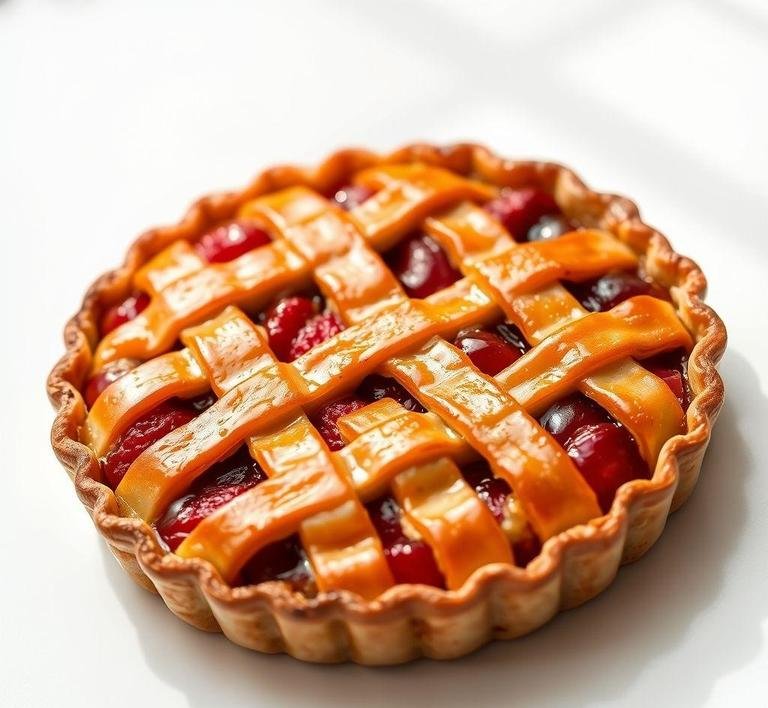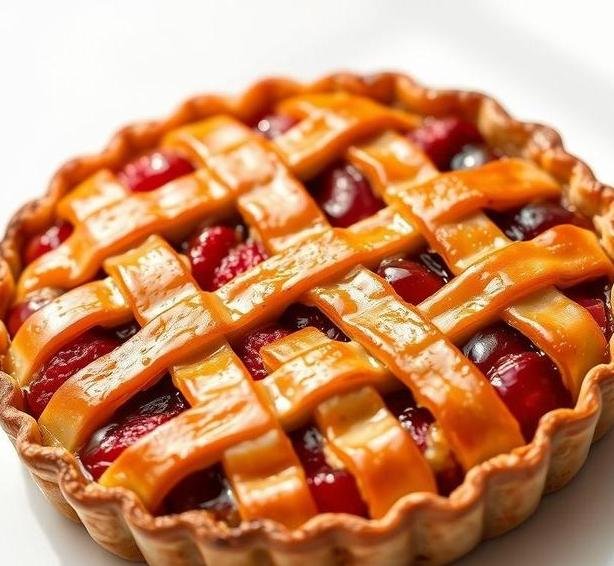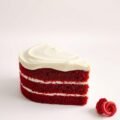Mary Berry’s Banbury Tart is a masterful rendition of a cherished English pastry, rooted in the market town of Banbury, Oxfordshire. Unlike the more modern and commonly seen Banbury Cakes, which are often flatter and use puff pastry, Mary Berry’s version leans into a more elegant, tart-like format-marrying a shortcrust pastry base with a sweet, spicy, and fruity filling.
Historically, Banbury Tarts (or Cakes) date back to at least the 16th century and were once known across England for their rich mincemeat-like interior made from dried fruits, citrus peel, spices, and a touch of alcohol. Mary Berry, ever the traditionalist with a flair for refinement, brings these rustic origins into the modern kitchen with a lighter, more balanced touch. Her version doesn’t feel heavy or overly spiced-instead, it’s fragrant, delicately sweet, and utterly charming, just like her.
Mary Berry’s Banbury Tart Recipe
Ingredients Needed

To create Mary Berry’s Banbury Tart, you’ll need a mix of pantry staples and a few classic baking essentials. Here’s what typically goes into her recipe:
For The Pastry
- 225g (8 oz) plain flour
- 100g (3.5 oz) cold unsalted butter, diced
- 1 tablespoon caster sugar
- 1 large egg yolk
- 2-3 tablespoons cold water
For The Filling
- 100g (3.5 oz) currants (or you can use a mix of sultanas and raisins)
- 50g (1.75 oz) finely chopped mixed peel
- 50g (1.75 oz) ground almonds
- 75g (2.5 oz) soft light brown sugar
- 1 teaspoon ground cinnamon
- A good grating of fresh nutmeg (or about ¼ tsp ground nutmeg)
- 1 tablespoon rum or brandy (optional but traditional)
- Zest of 1 lemon
- 50g (1.75 oz) unsalted butter, melted
For Glazing And Decorating
- 1 egg, beaten (for egg wash)
- A sprinkle of demerara sugar (for texture and sparkle)
Equipment Needed
Gathering the right tools makes this bake much smoother and more enjoyable. Here’s your toolkit:
- Mixing bowls (one large, one medium)
- Rolling pin
- 20cm (8-inch) tart tin with a loose bottom
- Baking parchment or foil
- Baking beans or dried pulses (for blind baking)
- Fine grater (for lemon zest and nutmeg)
- Pastry brush
- Fork and spoon
- Wire cooling rack
- Food processor (optional, for making the pastry quickly)
Instructions To Make Mary Berry’s Banbury Tart
Now, let’s get into the step-by-step process. Baking this tart is a therapeutic journey-rich with aroma, texture, and satisfaction.
Step 1: Make The Pastry
- Rub or process the pastry. In a large bowl (or a food processor), combine flour and cold butter. Rub together with your fingertips until the mix resembles breadcrumbs.
- Stir in the caster sugar.
- Add the egg yolk and a tablespoon of cold water. Mix together until a firm dough forms, adding more water if needed.
- Shape the dough into a disk, wrap in clingfilm, and chill for at least 30 minutes.
Step 2: Prepare The Filling
- While the pastry chills, mix together all filling ingredients in a bowl: currants, mixed peel, ground almonds, brown sugar, cinnamon, nutmeg, lemon zest, and alcohol if using.
- Pour in the melted butter and mix thoroughly until combined. The filling should be thick and sticky, like a mincemeat paste.
Step 3: Roll And Line The Tart
- Preheat your oven to 200°C (180°C fan) / 400°F / Gas Mark 6.
- Roll out the chilled pastry on a floured surface to about 3mm thick.
- Line your tart tin with the pastry, gently pressing into the sides. Trim any overhanging edges.
- Prick the base with a fork, line with parchment, fill with baking beans, and blind bake for 15 minutes.
- Remove the beans and parchment, and bake for another 5 minutes until the pastry base is just golden.
Step 4: Fill And Bake The Tart
- Spoon the fruity filling into the baked pastry case and smooth the top.
- Brush the top lightly with beaten egg, then sprinkle a touch of demerara sugar over for sparkle.
- Bake for another 20-25 minutes until the filling is golden and slightly puffed.
Step 5: Cool And Serve
Let the tart cool in the tin for about 10 minutes before transferring to a wire rack. Slice and serve warm or at room temperature, ideally with a dollop of clotted cream or a scoop of vanilla ice cream.
Tips And Tricks
- Chill the pastry well. This helps prevent shrinking and ensures a crisp, flaky texture.
- Use high-quality dried fruit. It really makes a difference in the depth and sweetness of the filling.
- Don’t skip the alcohol. Even if you’re not a fan, the small amount of rum or brandy adds a subtle warmth that defines this tart.
- Grate your spices fresh. Nutmeg especially shines when freshly grated.
- Blind baking is key. It prevents a soggy bottom-a cardinal sin in the world of British baking!
- Make ahead. The tart keeps beautifully for a couple of days in an airtight tin, and the flavors actually deepen over time.
Mary Berry’s Banbury Tart is a celebration of heritage, flavor, and elegant simplicity. It’s not just a pastry-it’s a journey into the heart of English baking, where dried fruit mingles with spice, and buttery pastry carries the memory of centuries. Perfect for tea-time or as a festive holiday treat, this tart is proof that sometimes, the old ways really are the best. And with Mary Berry guiding your hand-whether in spirit or on the page-you’re in the safest of flour-dusted hands.
Now, roll up those sleeves, get your apron on, and let the sweet, spicy scent of Banbury waft through your kitchen. You’re in for a real treat.
Easy Recipe Variations For Mary Berry’s Banbury Tart

Mary Berry’s Banbury Tart is a time-honoured classic-filled with a rich mixture of dried fruits, warm spices, and a splash of citrus zest, all tucked neatly into a buttery shortcrust pastry. But the beauty of this tart lies in how versatile it is. If you’re someone who likes to add a personal twist to traditional recipes, here are some easy and delicious ways to vary the original while still staying true to its comforting roots.
1. Swap Out the Fruits
While Mary’s original recipe typically features currants and raisins, you can play with the dried fruit combinations based on your taste or what’s in your pantry. Try:
- Chopped dried apricots and golden sultanas for a brighter, more tangy flavor.
- Dried cherries and cranberries to add a subtle tartness that balances the sweetness.
- Finely chopped dates and figs for a darker, richer finish that leans into sticky toffee territory.
2. Nutty Additions
Nuts add a wonderful crunch and depth to the filling. Consider folding in a handful of:
- Chopped walnuts or pecans for a toasty note.
- Slivered almonds, especially if you pair them with a dash of almond extract in the mix for a gentle marzipan undertone.
3. Zest and Booze
Mary often includes orange zest for that fresh zing, but you can play with citrus and spirits to deepen the flavour:
- Lemon or even grapefruit zest can lift the flavour beautifully.
- A tablespoon of brandy, dark rum, or even sherry stirred into the filling adds complexity and makes the tart feel a bit more luxurious-perfect for festive occasions.
4. Pastry Twists
Although traditional shortcrust pastry is lovely, you could opt for:
- A rough puff pastry base if you’re after something flakier and more indulgent.
- A wholemeal pastry, which lends a nuttier, more rustic feel and pairs beautifully with the fruit filling.
5. Sweet Glazes and Toppings
If you want to elevate the tart visually and texturally:
- Brush the top with apricot glaze for a glossy finish.
- Add a streusel topping (just a mix of butter, sugar, and flour) before baking for a crunchy crown.
Storing Leftovers
One of the wonderful things about Banbury Tart-aside from how irresistible it is when warm out of the oven-is that it stores beautifully. That makes it ideal for prepping ahead for guests, holidays, or just to enjoy with tea throughout the week.
Short-Term Storage:
Once baked and cooled, you can keep the tart in an airtight container at room temperature for up to 3 days. Make sure it’s not stored in a humid environment, as that can soften the pastry and encourage mould.
Refrigerating:
If you’d like to keep it a little longer, pop it into the fridge. Wrap it in foil or plastic wrap and it’ll stay fresh for up to a week. Just note that refrigeration can make the pastry a bit less crisp. To remedy that, reheat slices in a low oven (about 150°C/300°F) for 5-10 minutes to bring back that just-baked texture.
Freezing:
Yes, Banbury Tart freezes surprisingly well! Slice it into portions, wrap them individually in cling film, then pop them into a freezer bag or airtight container. It can be frozen for up to 3 months. Thaw overnight in the fridge or gently warm in the oven from frozen for best results.
What To Eat With Mary Berry’s Banbury Tart?
The tart is perfectly lovely on its own, but if you’re in the mood to go the extra mile-or want to present it as the grand finale to a meal-there are plenty of delightful accompaniments to consider.
1. Creams And Custards
- A spoonful of clotted cream adds a decadent, indulgent touch, especially if the tart is served warm.
- Pouring cream-either single or double-is a classic, no-fuss option.
- For an extra hug of comfort, try warm vanilla custard. The silky texture complements the dense fruit filling beautifully.
2. Ice Cream Pairings
If you’re serving it for dessert:
- A scoop of vanilla bean ice cream never fails.
- Cinnamon or spiced apple ice cream can echo and enhance the warming spices of the tart.
- For a slightly tangy contrast, try crème fraîche ice cream or Greek yogurt-based gelato.
3. Fruit Compotes or Fresh Berries
Balance the richness of the tart with a bright side of:
- Stewed rhubarb-its tartness is perfect.
- Mixed berry compote or even fresh raspberries or blackberries work wonders.
- A few slices of poached pear or apple can also elevate it into something restaurant-worthy.
4. Beverages to Pair With
Let’s not forget the drinks!
- A hot pot of Earl Grey or Darjeeling pairs beautifully.
- For something more indulgent, a glass of dessert wine, sherry, or even a spiced mulled wine in colder months can make for a divine pairing.
Conclusion
Mary Berry’s Banbury Tart is more than just a pastry-it’s a warm nod to traditional English baking, filled with history, flavour, and heart. Whether you’re sticking closely to her cherished original or giving it a modern twist with new fruits, nuts, and flavours, this tart remains a timeless treat.
Its versatility means it can be served up simply for tea or dressed up for dinner parties. It stores well, it travels well, and-most importantly-it always delivers on that deeply comforting, sweetly spiced flavour that makes it so beloved.
So, whether you’re a seasoned baker or just starting to dip your toes into the world of traditional British desserts, don’t hesitate to make the Banbury Tart your own. After all, as Mary Berry herself would likely say, the joy of baking lies not just in following the recipe-but in making it yours.
FAQs
What Are The Key Ingredients In Mary Berry’s Banbury Tart?
Mary Berry’s Banbury Tart recipe typically includes shortcrust pastry, raspberry jam, ground almonds, and a mixture of currants, sultanas, or raisins. The filling is also made with butter, sugar, eggs, and a hint of lemon zest, which gives the tart its distinct sweet and fruity flavor. The top is decorated with a traditional lattice pattern for a visually appealing finish.
Can I Substitute The Currants Or Sultanas In Mary Berry’s Banbury Tart?
Yes, you can substitute currants or sultanas with other dried fruits such as raisins, dried cranberries, or even chopped dried apricots. However, keep in mind that currants and sultanas provide a particular texture and sweetness, so the tart’s flavor may change slightly depending on what substitute you choose. If you prefer a less sweet tart, you could also opt for dried cherries or prunes.
How Do I Make The Lattice Top For Mary Berry’s Banbury Tart?
To create the lattice top for Mary Berry’s Banbury Tart, roll out the remaining shortcrust pastry and cut it into strips. Lay the strips horizontally across the filled tart, and then carefully fold back alternate strips to create a criss-cross pattern. Gently unfold the remaining strips over the folded ones to complete the lattice design. For a golden finish, brush the lattice with a little beaten egg before baking.


